Team-BHP
(
https://www.team-bhp.com/forum/)
The
Renault Duster Facelift has been launched in India at a price of between Rs. 8.47 - 13.57 Lakhs (ex-Delhi).
What you’ll like:
• Robust, abuse-friendly build & construction
• AMT variant is a convenient city commuter. Also the cheapest diesel AT in the segment
• A competent softroader. AWD system can take you places no 2WD can. 210 mm GC (
FWD = 205 mm)
• 109 BHP turbo-diesel is fast as well as fuel efficient. 84 BHP diesel offers excellent driveability
• Outstanding ride quality. Comfortable over any kind of road
• Balanced handling & dynamics. Stable at high speeds too
• Safety kit: Dual Airbags, ESP, ASR, ABS, EBD, BA, Hill Hold & Understeer Control
• Practical boot (475 - 1,064 liters of cargo capacity)
What you won’t:
• AMT is jerky and suffers from slow gearshifts. Creta AT, in comparison, is butter smooth
• Higher variants are too expensive for what is a dated model. Felt old at launch, feels even older today
• Interiors look cheap in many areas. Cost-cutting is very obvious
• Mediocre rear seat legroom. More like C1 segment sedans than C2
• Poor NVH insulation. Engine, road & wind noise are prominent inside the cabin
• No 3rd row of seats. You can buy 7-seater SUVs at the same $$$
• AMT unavailable with the AWD; Scorpio & XUV500 both offer 4x4 / AWD ATs
• Renault's after-sales service quality is a hit or miss
This review has been jointly compiled with Zappo. Thanks to him for the expert observations as an existing Duster owner! 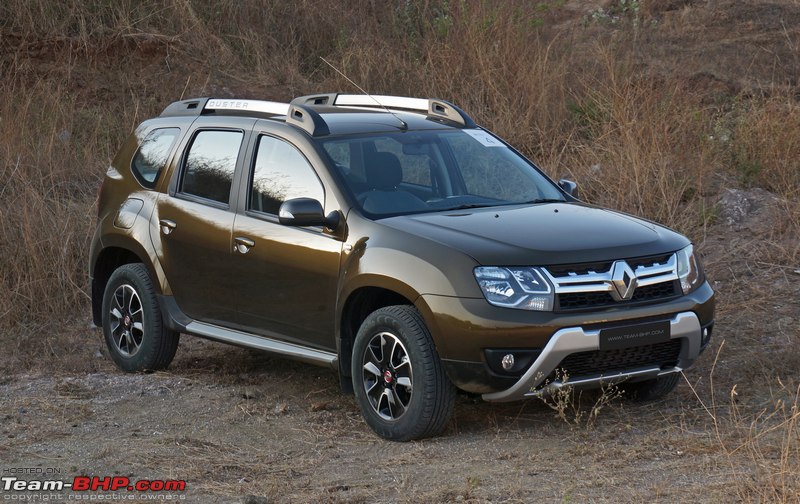
Since the Renault Duster has already been reviewed by Team-BHP, this report will only focus on changes made to the Facelift and AMT variant. For easy reference, here are direct links to the complete road-tests:
The FWD The AWD The 1.3L Turbo Petrol 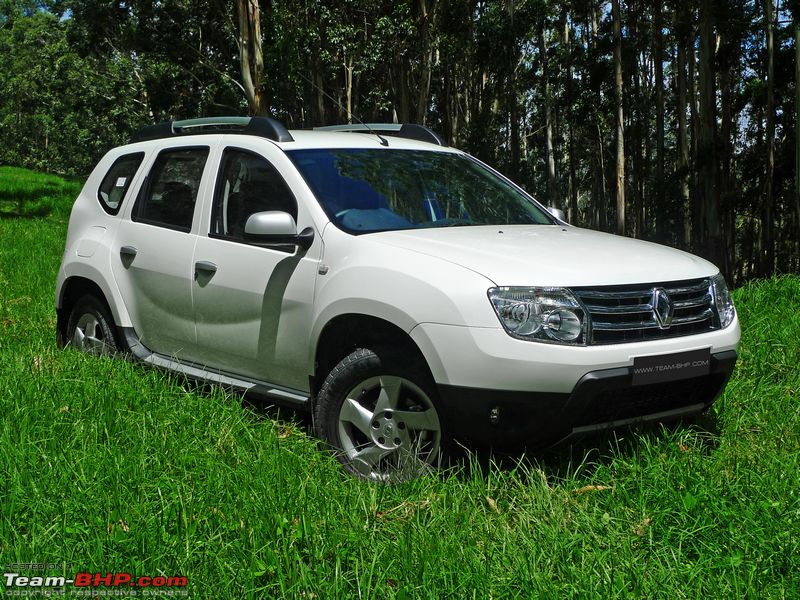

So, what's new on the outside?
No change in the Duster’s dimensions. The car measures 4,315 mm in length, 1,822 mm in width, and 1,695 mm in height. Ground clearance is 205 mm (210 mm for the AWD). The old girl might have been dressed up, yet there's no hiding her age:
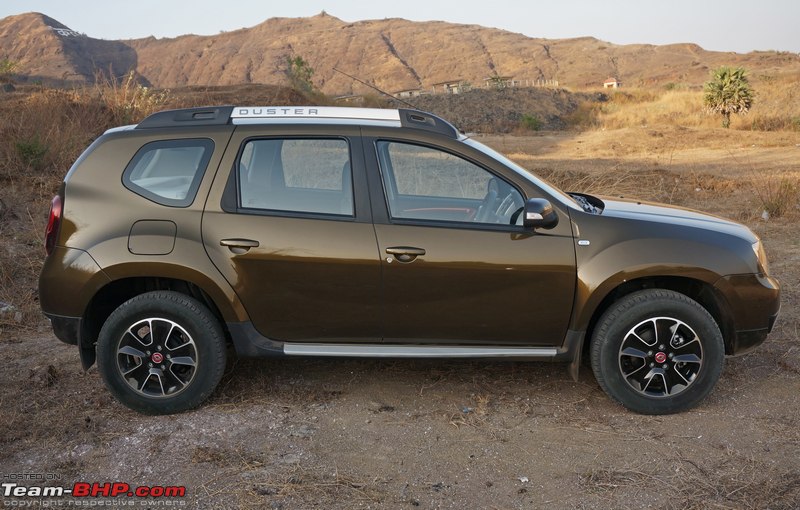
The front end wears changes to the headlights, grille, bumper & skidplate:
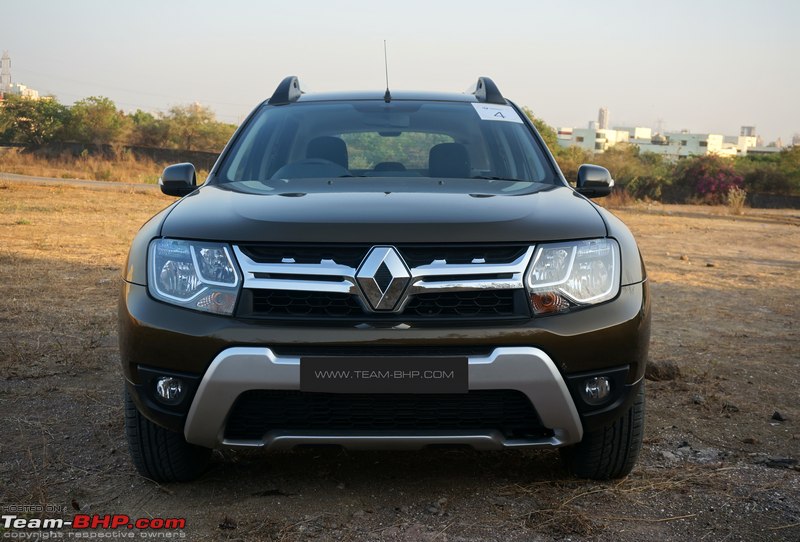
Here, there’s a pair of new tail-lamps, reworked bumper & skidplate:
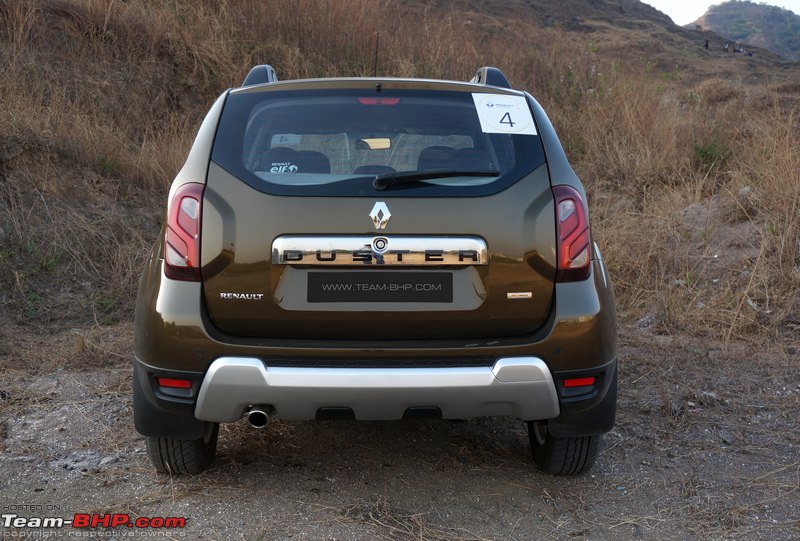
Renault says that the facelifted Duster has an upgraded "T4 Electrical & Electronics" architecture and a new "CMO 10" engine compartment. Remember the lighter clutch & lesser turbo-lag of the AWD variant? We're told that the Duster FWD also benefits from those changes now:
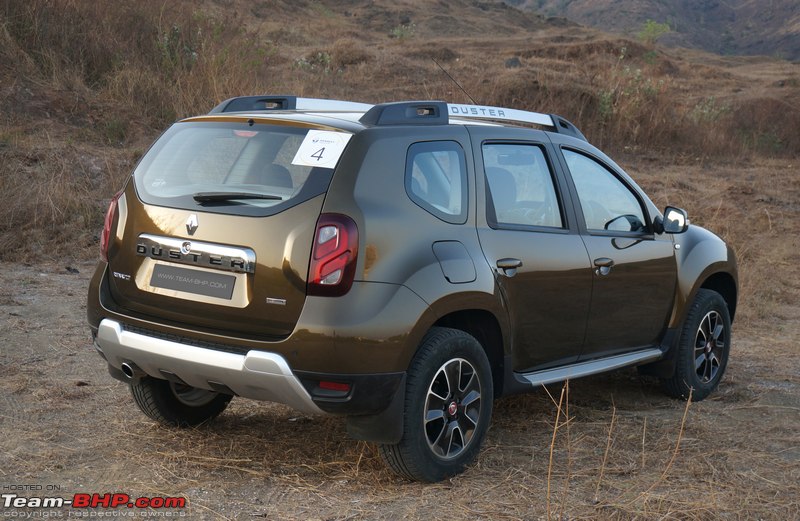
Subtle changes on the side (rims, roof-rail, ORVM):

Headlamp shape remains the same (
thus, no sheet metal changes), but the elements inside are new. No more circles here. We get silver lines instead of DRLs:
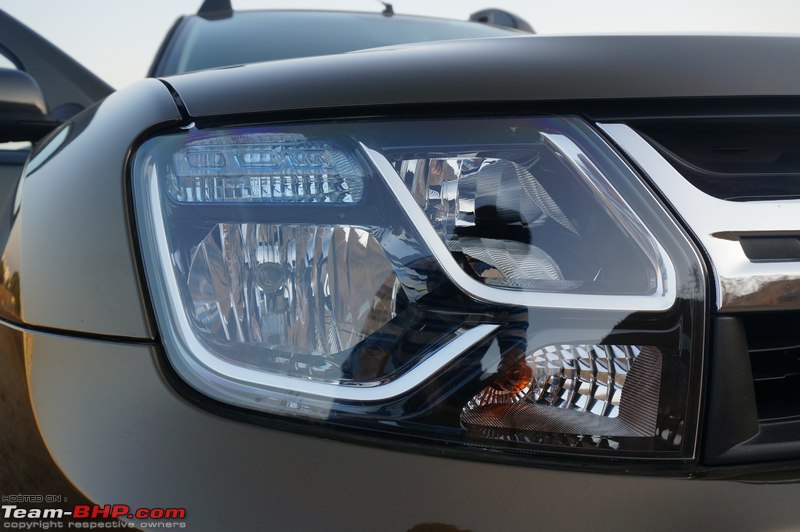
With all the lights switched on. Clockwise starting from the top left – pilot (parking) lamp, high beam, turn indicator & low beam. Because the outer shape is the same, owners of the pre-facelift version can get the new lights (front & rear):
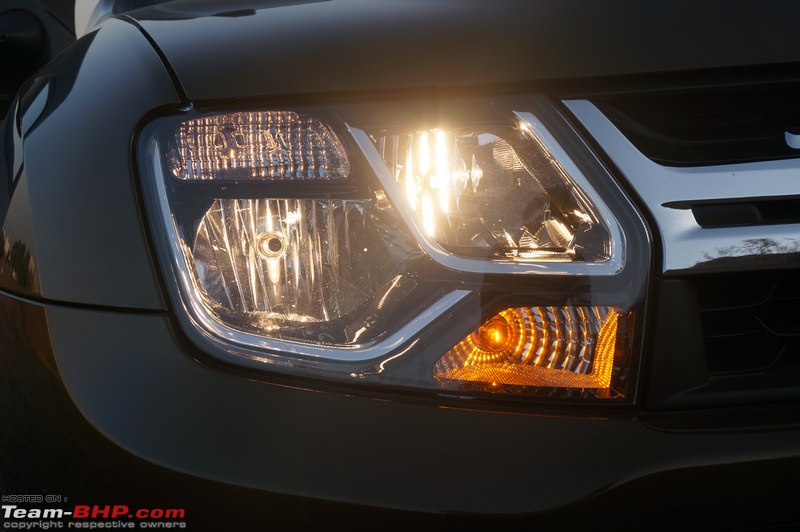
Radiator grille gets two thick, closely stacked, chrome slats (instead of three thin ones). The pattern of the grille has changed as well, while the Renault logo has grown in size. Similar arrangement to the Brazilian Duster (not European):
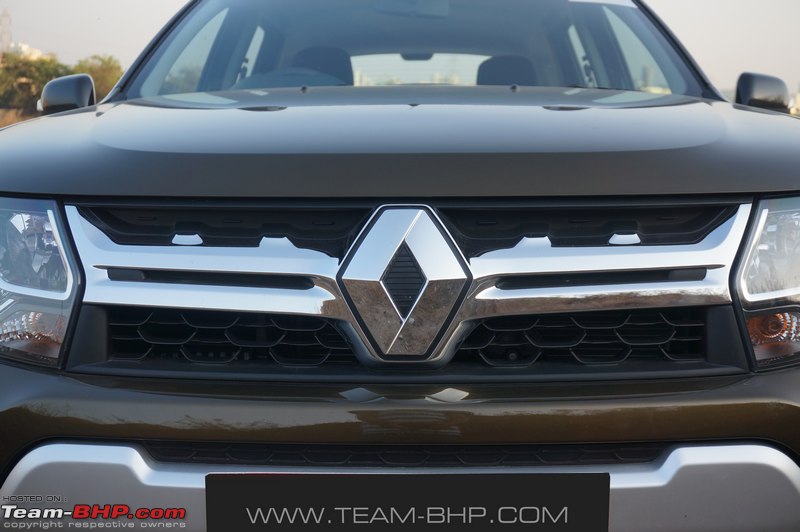
A larger & thicker silver skid plate. Silver has a dull finish (
just the way we like it), not glossy. Number plate is now fully housed on the skid plate:

The foglamp housing is now a separate piece. Good that the foglamps are still recessed. Will help to prevent damage when you take her offroad:

Air dam has grown. Front tow hook retains its original position:

These black inserts (on the front skidplate) look neat:

New black rims with a silver outline look so after-market'ish! Not to our taste. Red center cap was only on the AWD car. Terrano's wheels are sweeter (
link to image). 215/65 R16 tyre size remains unchanged:

Turn indicator moves from the front fender to the ORVM:
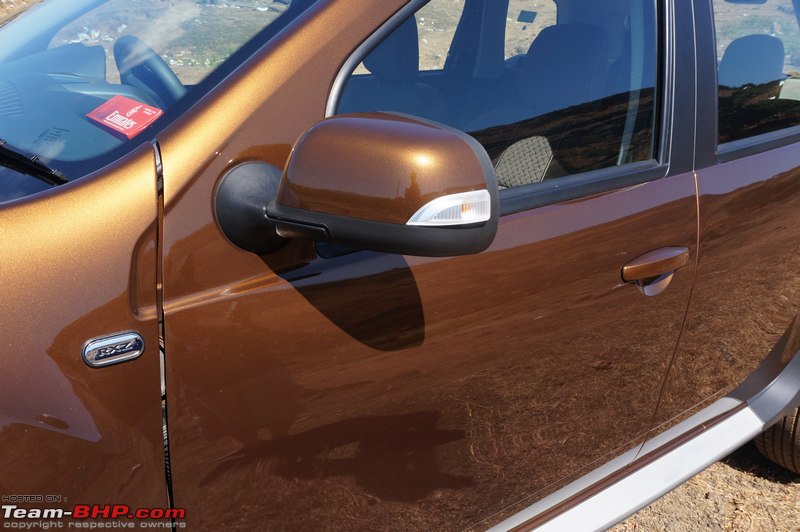
The AWD we got had its ORVMs in a carbon-fibre finish (FWD's were body-coloured):
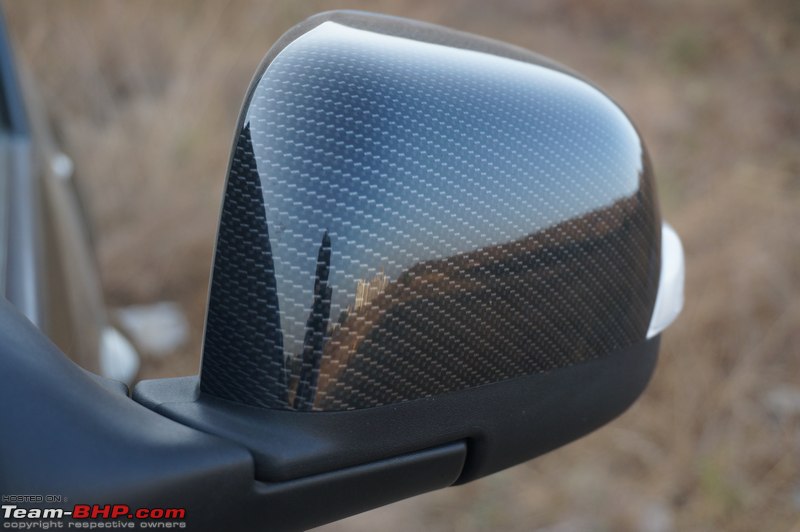
Badge indicating the trim level takes the place previously occupied by the turn indicator. Again, covering the hole up with a badge means no sheet metal change:

Even the top variant now gets body-coloured door handles. Thank God! Previously, these were finished in a gaudy silver:
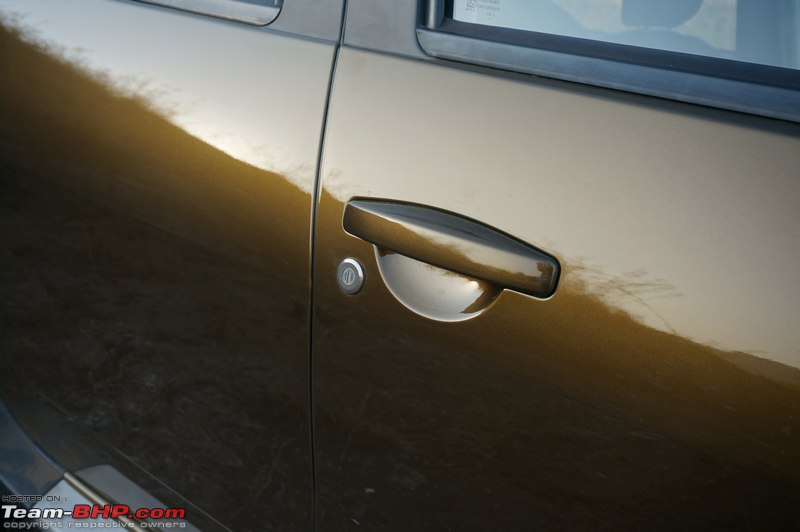
New jumbo-sized roof rails:
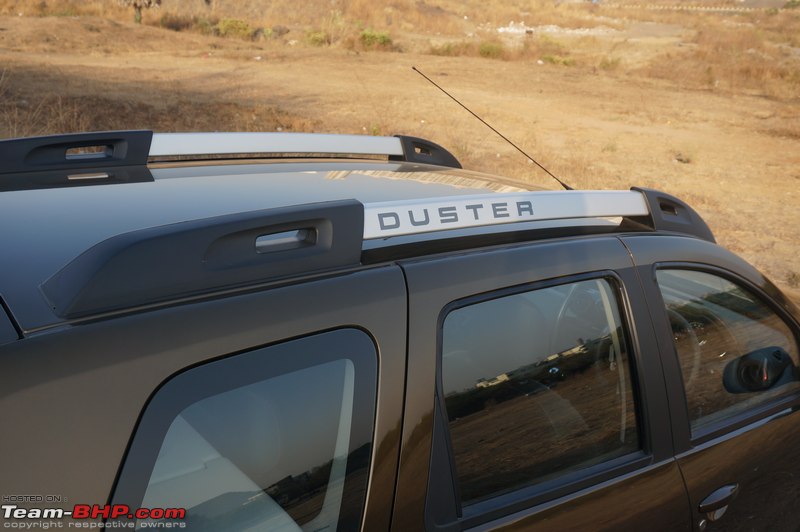
Prominent Duster branding on the chunky roof rails:
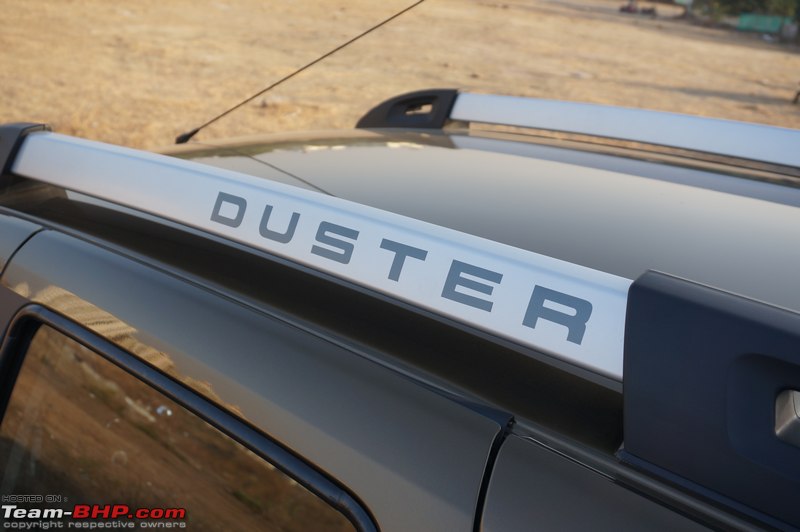
Roof rails felt tough & were properly fitted. These rectangular holes help to break the bulky look of the black holders:
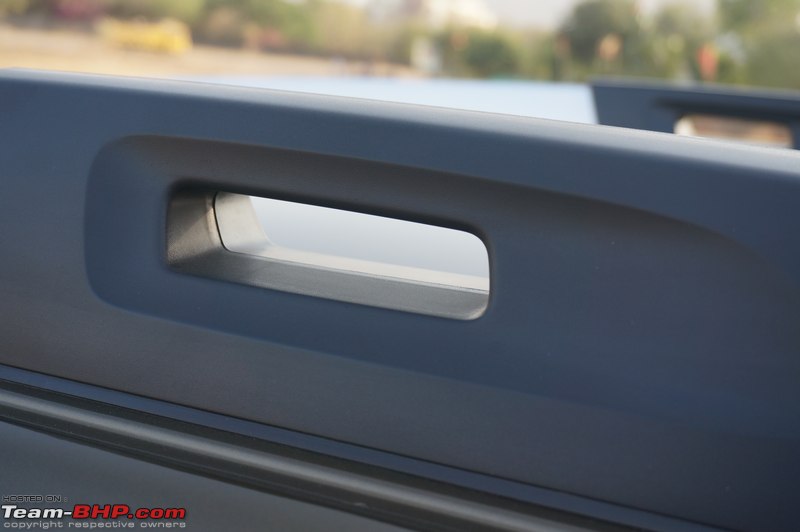
Like the headlamps, the tail-lamp's outer shape is the same. What's changed are the elements inside:

Looks smart! Pressing the brake pedal lights up the two elements on either side of the waterfall LED strip:
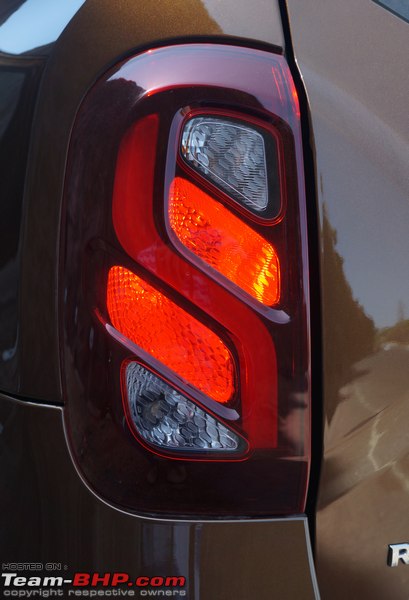
With all the lights switched on. LED strip activates with the pilot lamps:
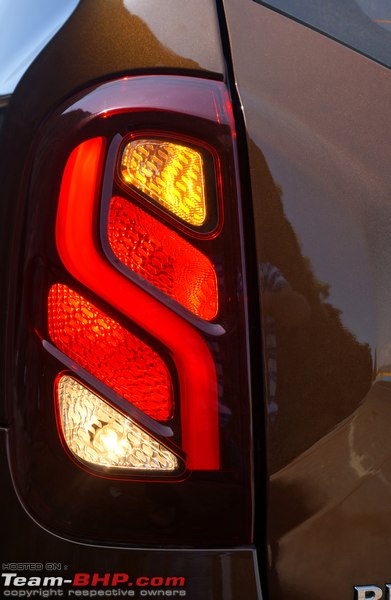
Duster lettering now sticks out of the chrome garnish. Keyhole entirely in silver (was earlier black):

Reversing camera sits above the number plate:

One simple badge, versus the earlier 3 (
reference image). AMT wears an 'Easy-R' badge here:

Rear bumper also gets a huge skid plate. 3 parking sensors continue to be present, although the center one is almost camouflaged in the black mesh design (
observe carefully and you'll spot it):
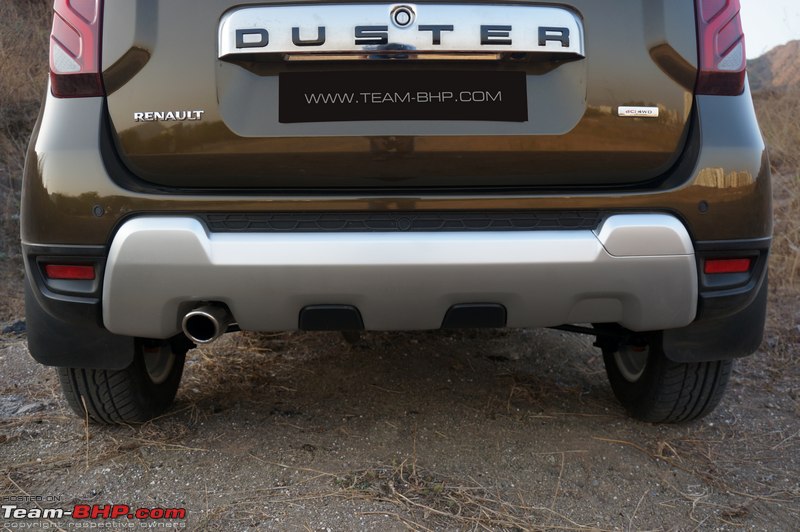
Rear tow hook is now neatly concealed by this cover:
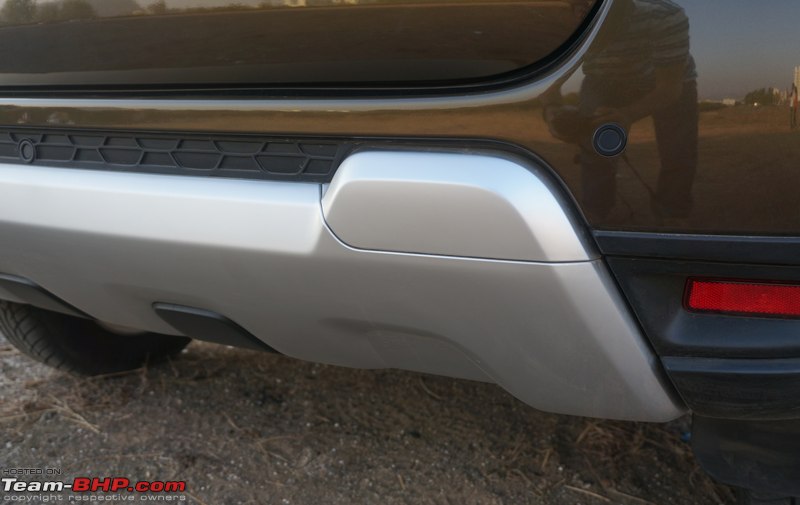
Rear skid plate gets two black inserts as well (like the front):
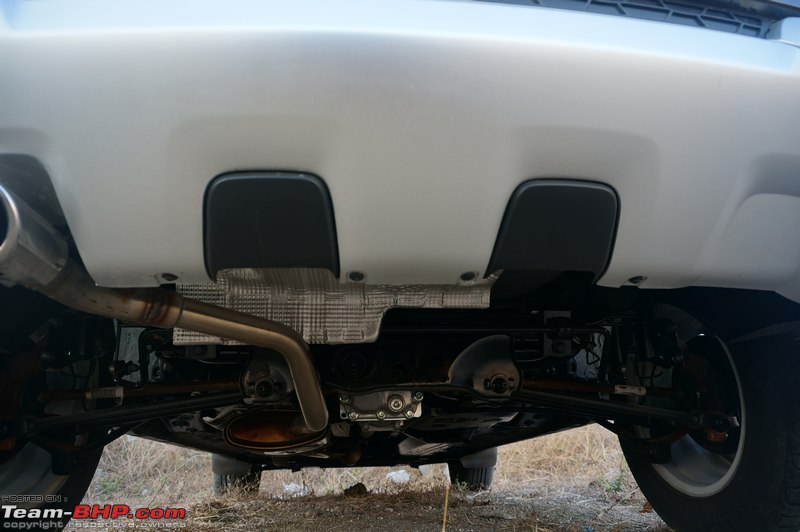
In the new Cayenne Orange colour:

So, what's new on the inside?
Before we deep dive into all the changes, let's take a quick look at the FWD variant. It's the same dashboard with minor changes. The centre fascia is finished in piano black. Brown interiors will garner a mixed response, and it sure doesn't go with all the exterior body colours (
this particular car has orange exteriors + brown interiors :D):
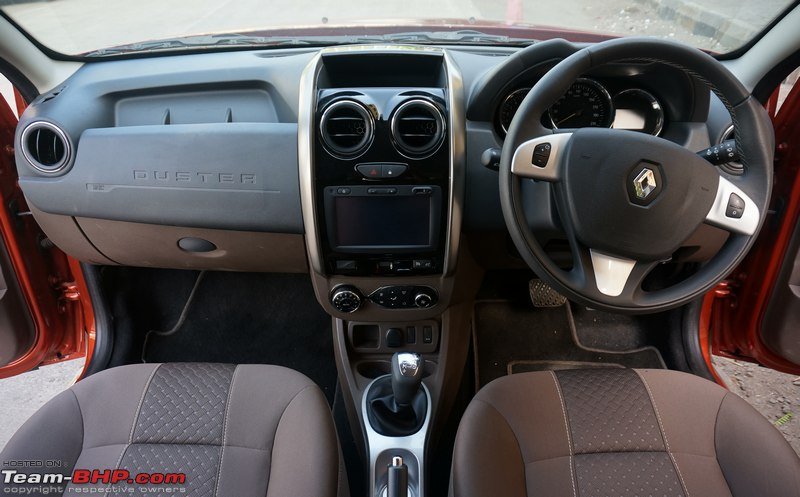
The FWD's door handles have a neutral silver shade (just wait till you see the AWD's):

The front seats:

Zooming in on the FWD's seat upholstery & white stitching:

This is the AWD variant. We much prefer its black & grey combination. Lots of red outlines - some will like them, others won't:

Brand 'Duster' embossed on the left looks awesome:

Ugly steering retained, with silver inserts on all 3 spokes:

Zooming in on the steering's red stitching:

Instrument cluster is the same. Cost-cutting means the revv counter is shared with the petrol. No redline and a diesel that's marked to 7,000 rpm!

AMT's MID gets a gear indicator. The "A" next to the "1" denotes "automatic" mode. Currently selected gear is shown in both, automatic & manual modes:

Light stalk is the same. Interesting find, you cannot switch the headlamps off if they are running in high beam (
you have to pull the stalk back to low beam mode, then switch them off):

What an absolute lack of taste! AWD gets a dark pink / crimson door handle. Yuck, a green body with these door handles. Without doubt, the worst colour combination we've ever come across:

Zooming in. What was Renault thinking? It's simply too garish. If you buy one, please apply a black / grey vinyl wrap over these door handles (
related DIY):

Doors lose the outdated pull-up locking knobs. You can unlock by simply pulling the chrome door handle. Locking is via the central locking button. The doors auto-lock once you start driving, but we guess the feature needs to be activated (
one media car didn't have it). No pull-up locking knobs means that rear passengers cannot individually lock their doors anymore:

ORVM controls are finally where they belong (
not below the handbrake). Yes, the ORVMs are electrically foldable. Driver's window now gets auto up/down with 'anti-pinch' functionality. The window lock switch (
for rear windows only) has changed:
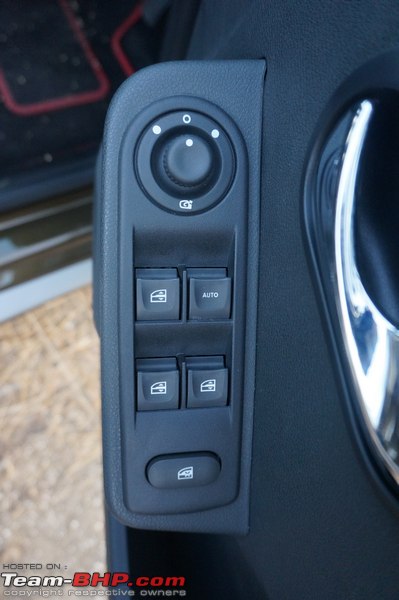
The front seats with crimson-black upholstery:
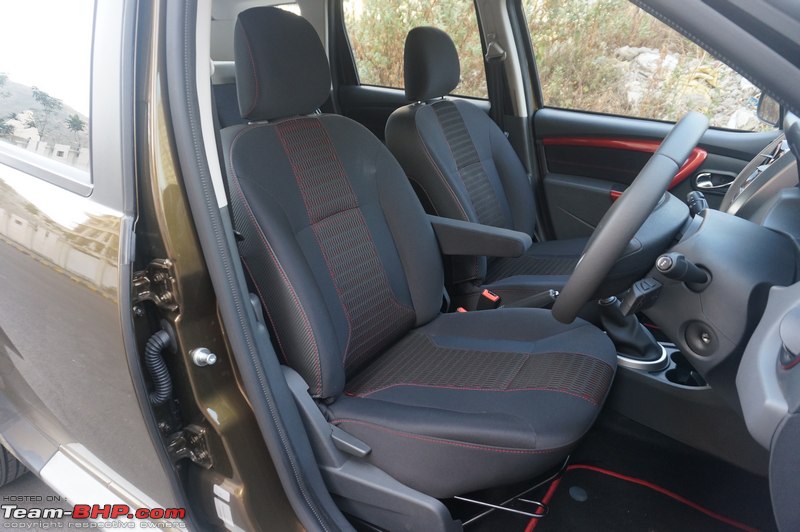
A closer look at the seat fabric:

Driver's chair gets a
very welcome armrest! It's comfortable to use. You can fold it up if you prefer not to rest your arm on it. Like in Mahindra SUVs, we wish there was one for the front passenger too:

Centre fascia with a piano-black finish:
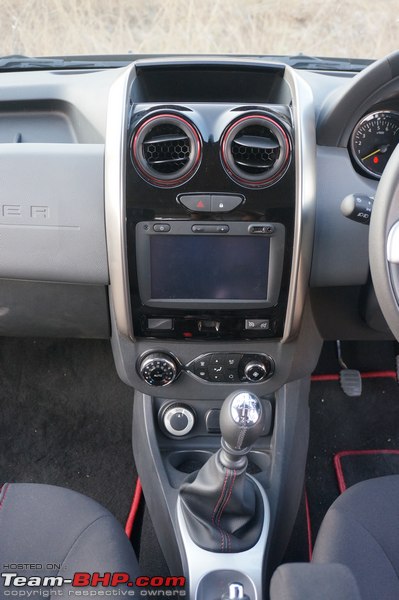
Air-con vents get chrome inserts on the covers, red outlines…

…and honeycomb mesh grilles. FWD gets these with a chrome outline (
link to image):

Buttons for the hazard lights & central locking are now placed just below the centre vents:
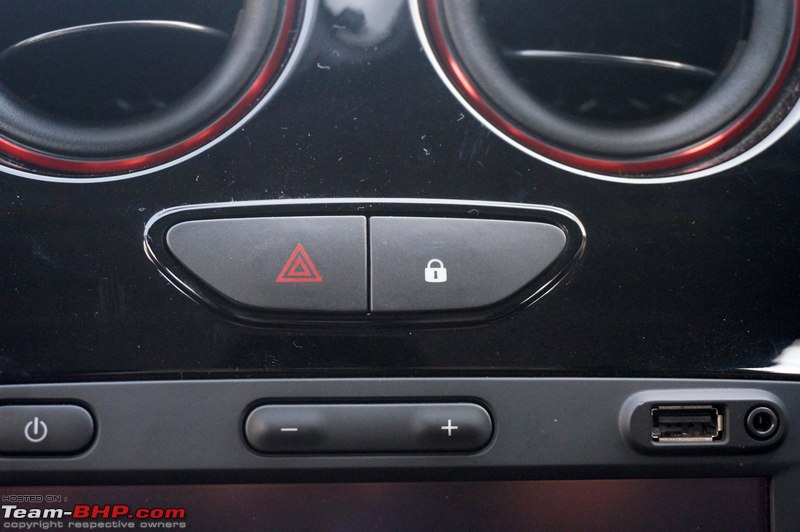
Plastic filler on the old location of those buttons:

Air-con controls now look like they're with the times! Funky layout. Climate control finally makes an entry on the Duster. Outdated recirculation slider knob is gone:

Observation - glovebox light remains on even after you lock the car (and the glovebox is left open). One has to remember to shut the glovebox lid. Simple usability error - earlier, this light would only activate if the headlamps were on:

Twin cupholders located just ahead of the gear lever with a removable carpet base:

Red stitching on the gear lever cladding too:

Centre console is now finished in a light silver:

While the ORVM switch has been relocated and the colour of the centre console has changed, the texture has been retained:

Appears to be the cabin temperature sensor next to the Bluetooth mic?

New key with larger / friendlier buttons. It's not a flippy:

Rear doorpad loses its big door handle:

A look at the rear bench with the crimson-black upholstery:

AWD gets its spare wheel placed inside the vehicle; FWD has it under the car:

Notice the carpeting below:

Let's take a quick look at the ICE. This MediaNav system is still by LG, yet the interface is completely new in many areas:

Don't miss the 'dark' button (
on the top left) to dim the screen if you find it too bright at night. MediaNav system features the usual lot of modern inputs (USB, AUX & Bluetooth streaming), telephony and navigation. The often reported niggle with Blackberry pairing continues to be present even in this iteration. The AVN offers voice recognition when paired with an iPhone:

You have to 'agree' before using the onboard navigation:

Navigation system shows the applicable speed limit too! Displaying 80 kph limit here:

You can check your coordinates:

Doubles up as a screen for the reversing camera. With adaptive guidelines:

The Duster AMT uses the familiar 109 BHP diesel & 6-speed gearbox:

To differentiate the Duster from other monocoque SUVs, Renault introduced a competent AWD system in 2014. All of its direct competitors (
EcoSport, Creta, S-Cross, Vitara Brezza etc.) are FWD only. Now, to expand the Duster's appeal, Renault has launched the AT variant. The number of diesel automatic SUVs in this segment is limited and all of them (
Creta, XUV500, Scorpio) are more expensive.
The AMT mechanism is a simple bolt-on job and it uses the Duster MT's existing gearbox. That makes it India's first 6-speed AMT.
How it works is pretty straightforward. Mechanically, the AMT gearbox is identical to the Duster's manual transmission. What's different is
how the clutch is operated and
how the gears are shifted. In the manual, the driver is responsible for these tasks. With the AMT, hydraulic actuators located in the engine bay operate the clutch and shift gears. There's no clutch pedal, and zero driver input is required for gearshifts, making it exactly like a conventional automatic to drive. Simply put, the mechanical functions of operating the clutch and gear lever have moved from inside the cabin to the engine bay. To know more about AMTs & how they work,
click here.
AMTs, as we know, are cheaper to build than proper automatic gearboxes (torque converters, dual clutches). This means Renault can price the Duster AMT lower (RXL Rs. 11.67 lakh; RXZ Rs. 12.87 lakh) than other diesel automatic SUVs like the Creta (SX+ Rs. 14.39 lakh) and Scorpio (S10 AT 13.81 lakh; S10 4WD AT 15.05 lakh). Compared to the MT, the Duster AMT carries a premium of Rs. 60,000.
This 6-speed AMT has been christened “Easy-R”. It is sourced from ZF Sachs and is being offered on the FWD 1.5L variant which develops 109 BHP (@ 4,000 rpm) and 245 Nm of torque (@ 1,750 rpm). Neither the Duster 85 PS nor the 110 PS AWD gets the new AMT.
In the city:
To start the car, the gear shifter has to be in N (neutral) position and the driver's foot has to be on the brake pedal. The engine won't crank if the gearbox is in D, R or M positions. There's no 'P' (park) mode or gear unlock button like in a conventional AT.
The Duster AMT has no problem rolling off from a standstill. Throttle response when starting off is good. The AMT functions like a regular automatic gearbox and, as the driver doesn't need to press a clutch pedal or shift gears, it makes the drive stress-free. Additionally, putting the car in D / M mode and releasing the brake pedal will result in the Duster crawling forward without any accelerator input. This 'creep function' is a blessing in bumper to bumper traffic as you can drive the Duster with only one pedal (i.e. the brake). Without any throttle input, the car will keep going at ~7 kph.
The sheer torque from the diesel engine helps matters and keeping up with urban traffic is easy. However, the gearbox suffers from slow gearshifts and there is a delay of a second or so from the time that one gear is disengaged and the next one is engaged. This results in a mild jerk and -
as we've noticed in other AMTs - the lull in acceleration makes your head / body move forward. Of course, AMTs behave better with higher torque engines and the difference from the AMT of smaller hatchbacks is noticeable. Things are a lot better than in the jerky Celerio, but there's no escaping the AMT's inherent drawback. If the car is being driven in a relaxed manner, things are much smoother (although you will still notice each gearshift). The gearbox's operation is silent too. It's only when the driver gets aggressive with the throttle that things get jerkier and result in your head swaying back & forth. If you've experienced torque-converter or dual-clutch automatics before, you'll be put off by the AMT. On the other hand, if you are new to the world of automatics, acceptability will be easier.
It is important to note that, while every upshift from 1st to 4th gears is felt, the shifting between 4th - 6th gears is smoother. And a tip that some might get used to, but most will find cumbersome: When accelerating up to speed, let off the accelerator at intervals, and the AMT will seize that opportunity to upshift - almost like you told it to!
On the open road:
Let's get one thing out of the way = the AMT is definitely suited to a more relaxed driving style than an aggressive one. It works well for a driver who prefers to build up speed gradually. The diesel engine has enough grunt to keep the Duster running at triple digit speeds all day long and, with a light foot, the transmission will be smoother. Driving in D mode is good on the highway as long as you are happy to cruise. Speaking of which, she cruises at 100 kph in 6th gear at a relaxed 2,250 rpm.
However, if the driver presses the accelerator down hard, there's a noticeable delay before the transmission figures things out and executes a downshift. Yes, the response time is rather slow. This can get particularly frustrating during overtaking manoeuvres and the driver will need to plan his moves carefully, particularly on single carriageways. A better way to overtake is outlined in the next paragraph.
In terms of outright performance, the Duster AMT is quick enough. You won't have any complaints with the engine as you would with the AMT.
Manual Mode:
The AMT comes equipped with 'Manual mode' that can be engaged by moving the gear shifter to D, and then to the left. Pull the shifter down to upshift and push it up to downshift. M mode comes in handy when one wants to overtake quickly. While the response time is far from instant, it's still a bit faster than D mode. M mode is useful to bring the engine into its powerband before an overtaking manouveur & also
during the actual overtaking (to prevent the AMT from an unintentional + slow upshift while you're overtaking). Driven hard, the engine will revv to the redline.
Use M mode when you desire engine braking as well. Driving downhill, M mode aids engine braking which in turn, reduces the workload on the brakes.
Eco Mode:
Like the Duster MT, the AMT has an Eco mode. It's engaged by hitting the switch at the base of the centre fascia. In Eco mode, the gearbox has a tendency to shift up earlier. The drop in power isn't as much as what we've seen in the TUV300 (for instance) and Eco mode is very useable here. Renault claims that the Duster will return 19.6 km/l in this mode. With diesel prices rising fast in India, many owners are likely to use Eco mode, particularly in the city. Nevertheless, even without Eco mode, the Duster is known for its excellent fuel economy. Considering that AMTs are usually more efficient than torque converter ATs, the Duster AMT will keep its owners happy in the area of FE.
Hill Start Assist:
The Duster is equipped with a 'Hill Start Assist' (HSA) feature. HSA holds the car in place on an incline for 2 seconds, giving the driver enough time to take his foot off the brake and press the accelerator. HSA is incredibly useful in AMTs! You will remember how we complained of roll-back in the Celerio AMT. This feature will help to prevent clutch burnout too. IMHO, every AMT should have HSA as standard. What's more, the Duster AMT gets ESP as well.
In summary, this is surely among the better AMTs we've driven. That said, if you can stretch your budget, the Creta 1.6L AT is totally worth the premium. Hyundai's engine & AT combination is butter-smooth in comparison, while the Creta's overall quality & finesse are two levels above the Duster.
Typical AMT shifter. No “P” mode or unlock button here. Sadly, at this price, no leather gear knob either:

Move the gear shifter to the left to engage manual mode. Push up for a downshift, pull down for an upshift:

Sufficient place to rest your left foot, although shockingly, no dead pedal has been provided. Lack of attention-to-detail, really! Brake pedal is wider than in the MT (
reference image):

The AMT sits low in the engine bay, and at the front of the engine:

The AMT is sourced from ZF Sachs. Made in Germany:
 Easy-R
Easy-R badging for the Automatic. Renault wants you to read Easy-R as
easier:
 Disclaimer: Renault invited Team-BHP for the Duster test-drive. They covered all the travel expenses for this driving event.
Disclaimer: Renault invited Team-BHP for the Duster test-drive. They covered all the travel expenses for this driving event.
Thread moved from the Assembly Line to Official Reviews!
Thanks for sharing, guys - rating review a full 5 stars :thumbs up.
Great Review Aditya clap:
Quote:
215/65 R16 tyre size remains unchanged
|
BUT the tyres have changed from the lovely MRF Wanderer Sports to Apollos now ! :confused:
Great review Aditya clap:
Its exciting how quickly AMT availability in models is increasing. They are a very good solution for Indian markets, maintaining fuel economy, providing ease and at the same time keeping the cost in check.
Coming to Duster, its surprising some of the colour combinations used by Renault on the AWD. They had a benefit of having AWD over Creta, but they ruined the interiors.
Awesome review Aditya and Zappo! Rating the thread a fully-deserving 5 stars.
Couple of points:
1. AMTs seem to be getting better with the introduction of HSA etc. Good or bad is a question to debate. If manufacturers concentrate on AMTs then we could possibly be looking at AMTs in cars up to say Rs 20 lacs which would deprive us of the DSG / DCTs of the world. Hopefully concentration would be on all technologies by manufacturers.
2. The inner handle color is nothing short of pathetic - pink... seriously! They should have gone with the carbon fiber finish like in the AWDs ORVMs. I'm sure most owners will do something about that.
3. The steering wheel should have been upgraded / changed. I found the Kwid also to have a better
design.
Great review, good to know that the Duster is a competent product. Has the FWD 110 BHP car got the same state of tune as the AWD ? i.e. Much lesser turbo lag.
Quote:
Originally Posted by avdhesh15
(Post 3939304)
1. AMTs seem to be getting better with the introduction of HSA etc. Good or bad is a question to debate. If manufacturers concentrate on AMTs then we could possibly be looking at AMTs in cars up to say Rs 20 lacs
|
Highly unlikely. Only Renault has taken the easier route to be able to sell a diesel AT. Understandable, as the car is pretty old now. There is no point making too many design changes to fit a new gearbox.
AMTs are largely restricted to the lowed end of the market.
Other the the Duster, the next most expensive cars with AMTs are the Dzire and the Zest which are compact sedans. The higher segments aren't as sensitive to FE and with smoothness being important, so CVTs, DCTs or Torque converter boxes will continue to be used.
It has been rightly pointed out that someone moving from a manual car won't be much perturbed by how an AMT shifts.
We are already in the habit of releasing the accelerator pedal when we change gear, so retaining that habit shouldn't be that difficult. And if one still finds the shifting unpredictable/jerky, they can always use the Manual mode.
I am however a little pissed that they decided not to pair the AMT with the AWD version. I would still pick up the AMT version as it takes away the heavy clutch that I now detest using having driven over a lakh kms of different manual cars. The Duster has the best suspension for our roads and the AMT just makes the deal so much sweeter.
The interiors seem to have taken a turn for the worse. Overall effect is that of an old woman with an overdose of makeup. Sorry Renault... not sure what the intent was, but crimson doorhandles? Seriously??
What a wonderfully competent car this is mechanically - drowned by an outdated, moronic, tasteless interior.
Superb review there Aditya. Crisp and highliting all the change points of the facelift.
Rated 5 worthy stars. :thumbs up
For me, the major novelty item with this updated version has to be the AMT. It still is miles away from being as seamless a shifter as a conventional slush box, but atleast brings the convenience of single leg driving to the Duster.
Though personally, I just can't approve to be putting in 15 big ones for a fully loaded one up here in Delhi. Even though the car is mechanically solid, the interiors are awefully dated for the times and neither does the quality bring any smiles to my face.
The new XUV or a pre-worshipped X1 make for pretty strong contenders if looking out in this space right now.
Still, the Duster has its appeal & this facelift should be able to keep the numbers ticking in today's fierce competition, albeit slowly.
Excellent review Aditya!
Strangely enough, with the brake lights lit up, the tail lamp has a striking resemblance to the Suzuki logo. Free advert for your competitor
:D
| All times are GMT +5.5. The time now is 01:43. | |


















































































